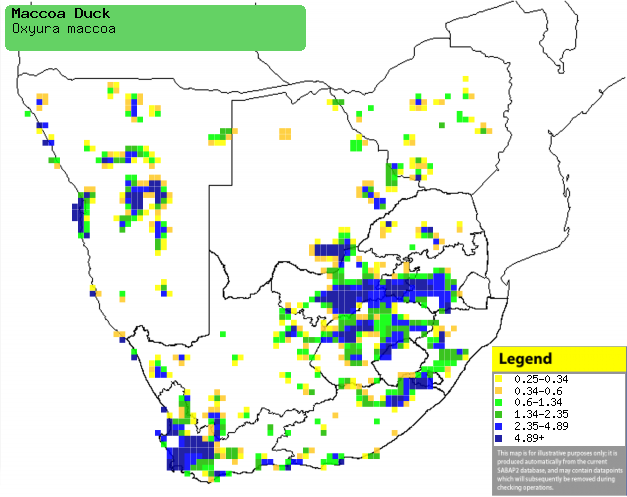|
Oxyura maccoa (Maccoa duck)
Bloubekeend [Afrikaans]; Idada (generic term for duck)
[Xhosa]; Letata (generic term for duck) [South Sotho]; Afrikaanse stekelstaart
[Dutch]; Érismature maccoa [French]; Maccoa-ente [German];
Pato-de-rabo-alçado-africano [Portuguese]
Life
> Eukaryotes >
Opisthokonta
> Metazoa (animals) >
Bilateria >
Deuterostomia > Chordata >
Craniata > Vertebrata (vertebrates) > Gnathostomata (jawed
vertebrates) > Teleostomi (teleost fish) > Osteichthyes (bony fish) > Class:
Sarcopterygii (lobe-finned
fish) > Stegocephalia (terrestrial
vertebrates) > Tetrapoda
(four-legged vertebrates) > Reptiliomorpha > Amniota >
Reptilia (reptiles) >
Romeriida > Diapsida > Archosauromorpha > Archosauria >
Dinosauria
(dinosaurs) > Saurischia > Theropoda (bipedal predatory dinosaurs) >
Coelurosauria > Maniraptora > Aves
(birds) > Order: Anseriformes
> Family: Anatidae
A diving duck with distinctive stiff tail that it
either keeps flat with the water surface or sticks up in the air. It is the only
stiff-tailed duck species in the region. The male in breeding plumage has a blue
bill, a chestnut coloured body and dark head, whereas the female and
non-breeding male have a dark brown bill and browny coloured body and head, with
a pale stripe running beneath the eye. The name 'maccoa' is derived from 'Macao'
or 'Macau' in China and is a misnomer because this species is indigenous to
Sub-Saharan Africa, not Asia. The distribution is divided between a population
in East Africa and the Ethiopian Highlands and another population within
southern Africa, where it is widely dispersed. They feed mainly on
bottom-dwelling invertebrates. Breeding is interesting in that the male holds a
territory containing multiple females, and females are expected to do all of the
work of making the nest, laying and incubating the eggs, and looking after the
ducklings. They are also nest parasites at times, laying their eggs not only in
other Maccoa duck nests but also in nests of other species of ducks and even
those of Red-knobbed coots.
Distribution and habitat
Found within Sub-Saharan Africa where there are two
discrete populations: (1) East Africa and Ethiopian highlands; and (2) southern
Africa. It has a scattered distribution over most of southern Africa, but is
mainly concentrated on the highveld (Gauteng, North-West Province, Mpumalanga and Free
State), the Western Cape, and upland areas of KwaZulu-Natal. Prefers permanent
wetlands that have rich concentrations of bottom-dwelling (benthic)
invertebrates.
|
 |
|
Distribution of Maccoa duck in southern Africa,
based on statistical smoothing of the records from first SA Bird Atlas
Project (©
Animal Demography unit, University of
Cape Town; smoothing by Birgit Erni and Francesca Little). Colours range
from dark blue (most common) through to yellow (least common).
See here for the latest distribution
from the SABAP2. |
Predators, parasites and pathogens
- Pathogens
- Clostridium botulinum (Type C) - produces
toxin that causes avian botulism.
- Mycobacterium causing avian tuberculosis
(recorded in captivity)
Food
- Mainly benthic invertebrates, obtained through diving:
- midge larvae and pupae
- Crustacea > Ostracoda
- Crustacea > Cladocera > Daphnia
- Mollusca > Gastropoda
- Aquatic plant matter makes up a small proportion of the
diet:
- Seeds:
- Persicaria (knotweed)
- Polygonum (knotweed)
- roots
Breeding
- The male is promiscuous and can have up to eight
females nesting simultaneously in his territory, which he guards
against intrusion by other males. Males with inferior territories are
ignored by females. Fights between males can occur both above and below
water, and include under water chases and physical attacks where birds hold
each other with their bills and beat each other with their wings. A male can
be territorial and sexually active for at least four months.
- The nest is built by the female in emergent
vegetation such as reeds (Phragmites), bulrushes (Typha) or
sedges (Cyperaceae) growing in fairly deep water. It consists of leaves and
stems from the surrounding vegetation pulled down and bent into bulky bowl,
with eggs lying from 8-23 cm above water level. It is vulnerable to flooding
because it is secured to the emergent vegetation. As in the White-backed
duck, the nest is sometimes built on top of an old Great-crested
grebe or Red-knobbed coot
nest.
- Breeding season is year-round.
- The female lays a clutch of 2-9 eggs, each egg
being laid at one to two day intervals. Clutches of more than nine eggs (up
to 16 have been recorded) are the result of nest parasitism by other
females. Incubation (by the female only) starts after clutch
completion and takes 25-27 days before the eggs hatch. During this time she
is on the nest for about 72% of the time, which uses up a lot of her energy.
In fact, unless she lays down fat deposits greater than 20% of her body
weight before nesting begins, she is unlikely to be able to endure this
period of incubating and sometimes has to desert her clutch.
- Ducklings leave the nest soon after hatching and
start diving and feeding for themselves immediately. Only the female stays
with her brood and she does so for anything ranging from 2-5 weeks.
Initially she keeps them in the vicinity of the nest and broods them on the
nest at night.
- Nest parasitism is common: other than laying
eggs in each other's nests, they have also been recorded laying them in Fulvous
duck, Egyptian goose, Hottentot
teal, Southern pochard and Red-knobbed
coot nests.
Threats
No serious threats and in fact its distribution has
expanded as a result of the construction of artificial water bodies (e.g. farm
dams).
References
-
Hockey PAR, Dean WRJ and Ryan PG (eds) 2005. Roberts
- Birds of southern Africa, VIIth ed. The Trustees of the John Voelcker
Bird Book Fund, Cape Town.
|
